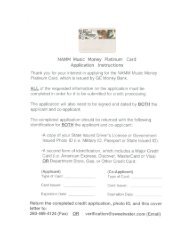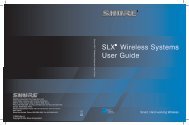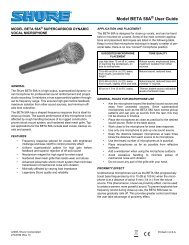Create successful ePaper yourself
Turn your PDF publications into a flip-book with our unique Google optimized e-Paper software.
Effects List<br />
62: 2VOI PITCH SHIFTER (2VOICE PITCH SHIFTER)<br />
Shifts the pitch of the original sound. This 2-voice pitch shifter has two<br />
pitch shifters, and can add two pitch shifted sounds to the original<br />
sound.<br />
fig.MFX-62<br />
L in<br />
R in<br />
Parameter Value Description<br />
Pitch 1:<br />
Coarse<br />
Pitch 1:Fine<br />
Pitch 1:Delay<br />
A pitch shifter in which the amount of pitch shift is varied by a 16-step<br />
sequence.<br />
fig.MFX-63<br />
-24-+12 semi<br />
-100-+100 cent<br />
0–1300 ms, note<br />
Pitch 1:Feedback -98– +98%<br />
Pitch 1:Pan<br />
L64-63R<br />
Adjusts the pitch of Pitch Shift 1<br />
in semitone steps.<br />
Adjusts the pitch of Pitch Shift<br />
Pitch 1 in 2-cent steps.<br />
Adjusts the delay time from the<br />
direct sound until the Pitch Shift 1<br />
sound is heard.<br />
Adjusts the proportion of the<br />
pitch shifted sound that is fed<br />
back into the effect. Negative (-)<br />
settings will invert the phase.<br />
Stereo location of the Pitch Shift<br />
1 sound<br />
Pitch 1:Level 0–127 Volume of the Pitch Shift1 sound<br />
Pitch 2:<br />
Coarse<br />
Pitch 2:Fine<br />
Pitch 2:Delay<br />
-24-+12 semi<br />
-100-+100 cent<br />
0–1300 ms, note<br />
Pitch 2:Feedback -98– +98%<br />
Pitch 2:Pan<br />
L64-63R<br />
Pitch 2:Level 0–127<br />
Settings of the Pitch Shift 2<br />
sound.<br />
The parameters are the same as<br />
for the Pitch Shift 1 sound.<br />
Low Gain -15– +15 dB Gain of the low range<br />
High Gain -15– +15 dB Gain of the high range<br />
Level Balance<br />
Balance<br />
A100:0B-A0:100B<br />
D100:0W-D0:100W<br />
Level 0-127 Output Level<br />
63: STEP PITCH SHIFTER<br />
L in<br />
R in<br />
Level 1<br />
Pan 1 R<br />
2Voice Pitch Shifter<br />
Pan 2 L<br />
Level 1<br />
Step Pitch Shifter<br />
Step Pitch Shifter<br />
Balance D<br />
Pan 1 L<br />
Pan 2 R<br />
Balance D<br />
L out<br />
Balance W<br />
Balance W<br />
R out<br />
Volume balance between the<br />
Pitch Shift 1 and Pitch Shift 2<br />
sounds<br />
Volume balance between the direct<br />
sound (D) and the pitch shifted<br />
sound (W)<br />
2-Band<br />
EQ<br />
2-Band<br />
EQ<br />
L out<br />
R out<br />
Parameter Range Explanation<br />
Attack 0–127<br />
Gate Time 0–127<br />
Fine<br />
Delay Time<br />
Adds reverberation to the sound, simulating an acoustic space.<br />
fig.MFX-64<br />
-100– +100 cent<br />
0–1300 ms, note<br />
Feedback -98– +98%<br />
Low Gain<br />
High Gain<br />
-15– +15 dB<br />
-15– +15 dB<br />
Balance D100:0W–D0:100W<br />
Speed at which the amount of<br />
pitch shift changes between steps<br />
Duration of the pitch shifted<br />
sound at each step<br />
Pitch shift adjustment for all steps<br />
(2-cent units)<br />
Delay time from the original<br />
sound until the pitch-shifted<br />
sound is heard<br />
Level 0–127 Output volume<br />
64: REVERB<br />
L in<br />
R in<br />
Parameter Value Description<br />
Type<br />
Pre Delay<br />
ROOM1, ROOM2,<br />
STAGE1, STAGE2,<br />
HALL1, HALL2<br />
0.0–100.0 ms<br />
Proportion of the pitch-shifted sound<br />
that is to be returned to the input<br />
(negative values invert the phase)<br />
Amount of boost/cut for the lowfrequency<br />
range<br />
Amount of boost/cut for the highfrequency<br />
range<br />
Volume balance of the original sound<br />
(D) and pitch-shifted sound (W)<br />
Type of reverb<br />
ROOM1: dense reverb with<br />
short decay<br />
ROOM2: sparse reverb with<br />
short decay<br />
STAGE1: reverb with greater<br />
late reverberation<br />
STAGE2: reverb with strong<br />
early reflections<br />
HALL1: reverb with clear reverberance<br />
HALL2: reverb with rich reverberance<br />
Adjusts the delay time from the direct<br />
sound until the reverb sound<br />
is heard.<br />
Time 0–127 Time length of reverberation<br />
HF Damp<br />
Balance D<br />
Reverb<br />
Balance D<br />
200–8000 Hz,<br />
BYPASS<br />
Adjusts the frequency above which<br />
the reverberant sound will be cut.<br />
As the frequency is set lower,<br />
more of the high frequencies<br />
will be cut, resulting in a softer<br />
and more muted reverberance.<br />
If you do not want to cut the<br />
high frequencies, set this parameter<br />
to BYPASS.<br />
Low Gain -15– +15 dB Gain of the low range<br />
High Gain -15– +15 dB Gain of the high range<br />
Balance D100:0W–D0:100W<br />
2-Band<br />
EQ<br />
Balance W<br />
Balance W<br />
2-Band<br />
EQ<br />
Level 0–127 Output Level<br />
L out<br />
R out<br />
Volume balance between the direct<br />
sound (D) and the reverb sound (W)<br />
Parameter Range Explanation<br />
Step 01–16<br />
Rate<br />
-24–+12 semi<br />
0.05–10.00 Hz, note<br />
Amount of pitch shift at each step<br />
(semitone units)<br />
Rate at which the 16-step sequence<br />
will cycle<br />
77
















